Table of Contents
As a CEO of an organization with remote set-up, keeping your employees engaged and productive is a challenge. The reason being – remote work brings particular performance hurdles. On the flip side, it also provides organizations with exceptional potential to reach their maximum operational capabilities.
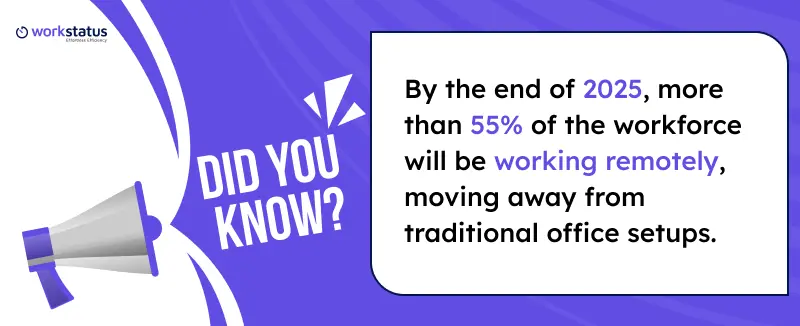 The blog discusses remote team productivity roadblocks while introducing functional methods to increase team productivity. It includes defining clear objectives and choosing appropriate productivity tools for remote teams.
The blog discusses remote team productivity roadblocks while introducing functional methods to increase team productivity. It includes defining clear objectives and choosing appropriate productivity tools for remote teams.
The CEO strategies for remote work discussed in the blog will direct you toward creating a better and more productive remote team. Let’s find out how.
Key Challenges Affecting Remote Productivity
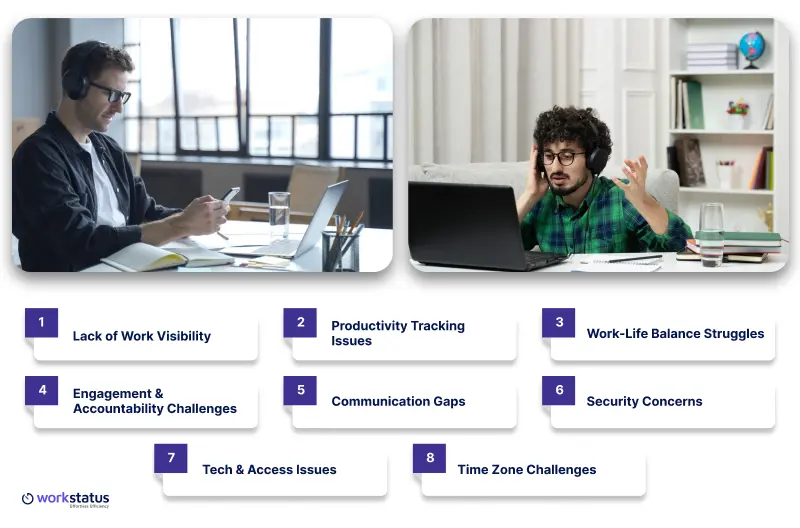 Managing remote teams has additional difficulties. Although remote work flexibility brings many advantages, it also comes with productivity-limiting obstacles.
Managing remote teams has additional difficulties. Although remote work flexibility brings many advantages, it also comes with productivity-limiting obstacles.
Let’s look at the main factors that reduce the remote workforce efficiency:
Lack of Work Visibility
- Difficulty in tracking employee progress without direct oversight.
- Uncertainty about whether tasks are being completed on time.
- Limited insight into day-to-day workflows and bottlenecks.
Engagement & Accountability Challenges
- Employees may feel disconnected from the team and its goals.
- Lack of immediate supervision can lead to a decrease in personal responsibility.
- Disengagement from tasks and unclear expectations can lower productivity.
Productivity Tracking Issues
- Traditional tracking methods don’t work well in remote settings.
- Difficulty in measuring work output without proper tools.
- Inconsistent or inaccurate data on employee performance.
Communication Gaps
- Team performance suffers from delayed message response times and lost messages.
- Poor communication develops because team members do not meet in person.
- Remote teams face difficulties in maintaining alignment across members.
Work-Life Balance Struggles
- Working life boundaries that mix with private life open the door to professional burnout.
- Staff members commonly feel compelled to put in extra hour work due to work pressure.
- Undefined work parameters create physical exhaustion and reduce team outputs.
Security Concerns
- Users of personal technology and unsecured network paths connect to company systems.
- Increased risk of data breaches and cyberattacks.
- Keeping remote data secure throughout access procedures proves difficult to achieve.
Tech & Access Issues
- The remote workspace lacks the necessary tools or technological equipment.
- Internet connections that are unreliable lead to work interruptions.
- Work efficiency might suffer from problems with software or hardware technology.
Time Zone Challenges
- Delays in communication and decision-making due to different time zones.
- Difficulty scheduling meetings that accommodate all team members.
- Feelings of isolation for team members with limited overlapping work hours.
Although these barriers can interrupt productivity in remote work; they are not impossible to overcome. With some productivity strategies and productivity tools for remote teams, CEOs can build an environment where remote teams can flourish.
Improving your oversight systems, engagement activities, accountability roles, and communication channels will boost team efficiency, motivation, and productivity levels.
Proven Strategies to Boost Remote Productivity
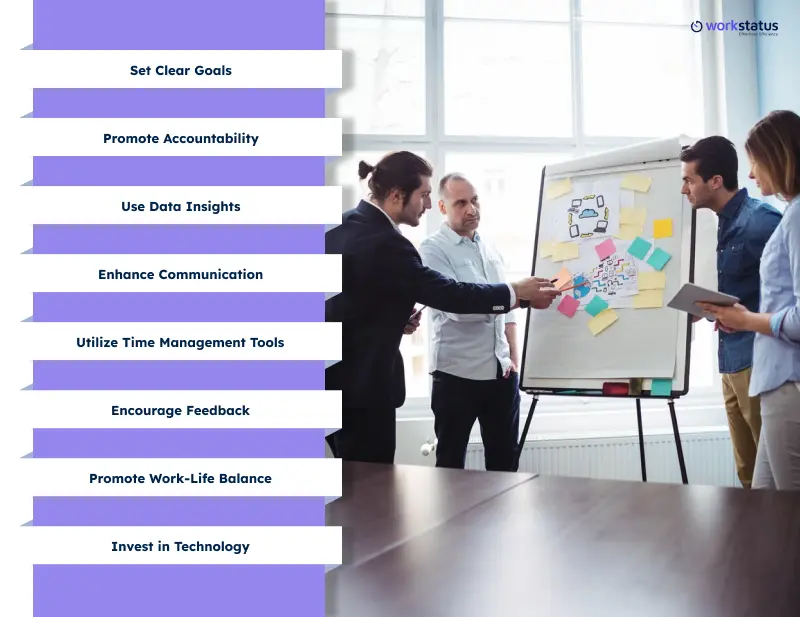 Enhancing remote team productivity requires strategic methods and tools to boost performance, engagement, and stability.
Enhancing remote team productivity requires strategic methods and tools to boost performance, engagement, and stability.
Here are some proven CEO productivity tips to help increase remote team productivity:
Set Clear Goals
- Clearly defined goals help ensure everyone knows what is expected.
- Break down large tasks into manageable milestones to keep progress measurable.
- Align team objectives with company goals to maintain focus and motivation.
Promote Accountability
- Encourage team members to take ownership of their work and outcomes.
- Set up regular check-ins or progress reports to monitor performance.
- Create a results-oriented culture where success is tied to individual contributions.
Use Data Insights
- Employ productivity tools for remote teams that provide data on employee performance.
- Analyze metrics such as time tracking, project completion rates, and overall productivity.
- Use data to identify areas for improvement and make informed decisions about resource allocation.
Enhance Communication
- Messaging apps should be used alongside video calls and project management tools for connection.
- The organization should develop a workplace culture that accepts feedback and ideas from all departments.
- The team should meet regularly to maintain alignment while receiving updates about company priorities.
Utilize Time Management Tools
- The organization should use time tracking software to manage time efficiently.
- Time-blocking should serve as a method for task prioritization.
- Tools should be available to help people organize their workload better and diminish distractions.
Encourage Feedback
- Create a feedback loop for employees to share challenges and successes.
- Offer regular constructive feedback to guide performance.
- Use surveys or one-on-one meetings to gather input on improving productivity.
Promote Work-Life Balance
- Encourage employees to set boundaries between work and personal time.
- Implement flexible working hours to help team members manage their schedules.
- Offer wellness programs or mental health support to maintain employee well-being.
Invest in Technology
- Provide remote teams with collaboration, communication, and productivity tools.
- Ensure secure and reliable systems to prevent disruptions.
- Use workforce management software to automate tasks and improve efficiency.
Thus, remote teams succeed when leaders provide suitable productivity tools for remote teams combined with employee well-being strategies.
How Workstatus Enhances Remote Team Productivity?
 Workstatus has a complete set of features that improve remote team management. The integrated real-time tracking system and task management features in Workstatus enhance productivity.
Workstatus has a complete set of features that improve remote team management. The integrated real-time tracking system and task management features in Workstatus enhance productivity.
Its analytic capabilities enable businesses to maintain accountability within remote teams.
Here are the key features of Workstatus that drive productivity:
Time Tracking
![]() Workstatus enables its users to achieve real-time time tracking which enables precise time logs and effective task monitoring.
Workstatus enables its users to achieve real-time time tracking which enables precise time logs and effective task monitoring.
Managers deploy Workstatus to check team performance and distribute resources properly while employees receive accurate pay for their work.
Activity Monitoring
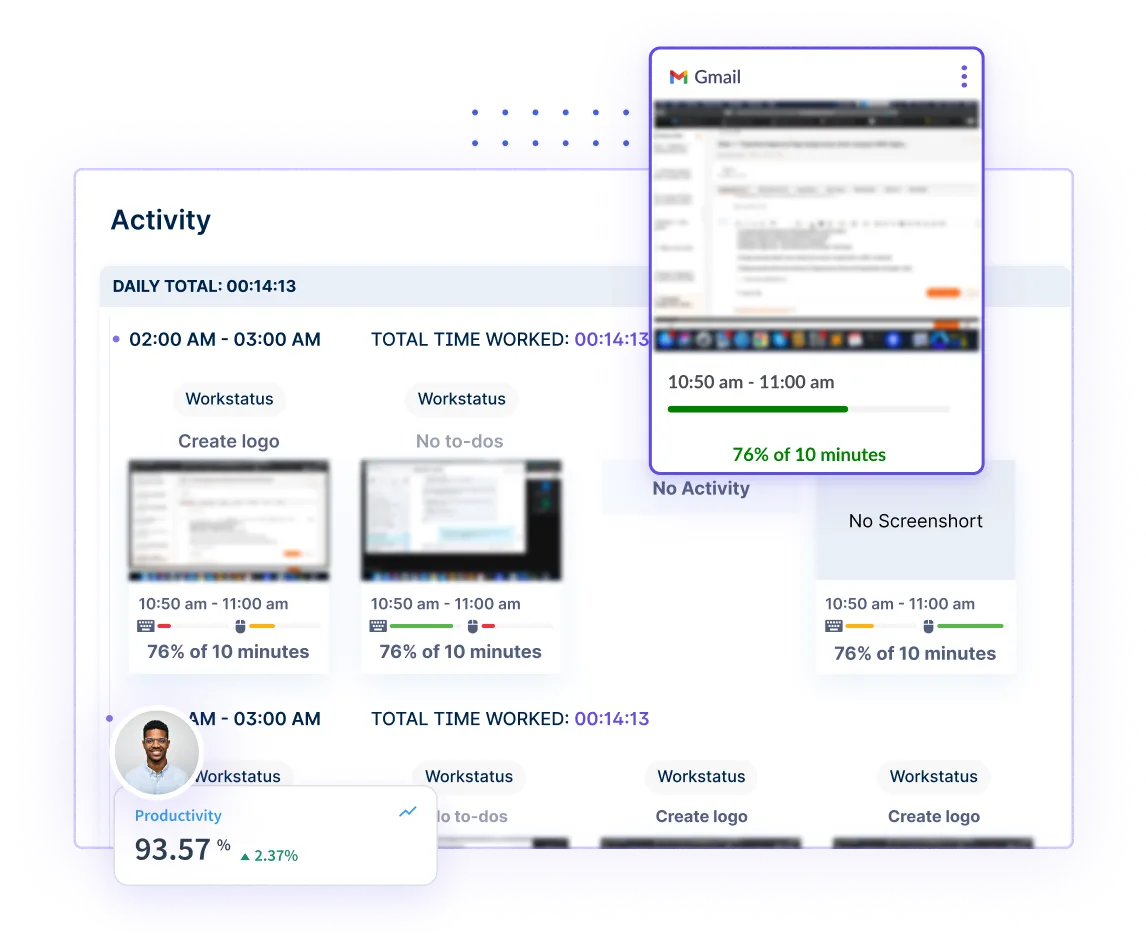 Workstatus offers advanced remote employee monitoring by recording screenshots and keyboard and mouse actions, and it also tracks application utilization.
Workstatus offers advanced remote employee monitoring by recording screenshots and keyboard and mouse actions, and it also tracks application utilization.
The tool creates focused work environments for employees and provides managers with actionable work habit data, which drives productive performance improvements.
Task Management
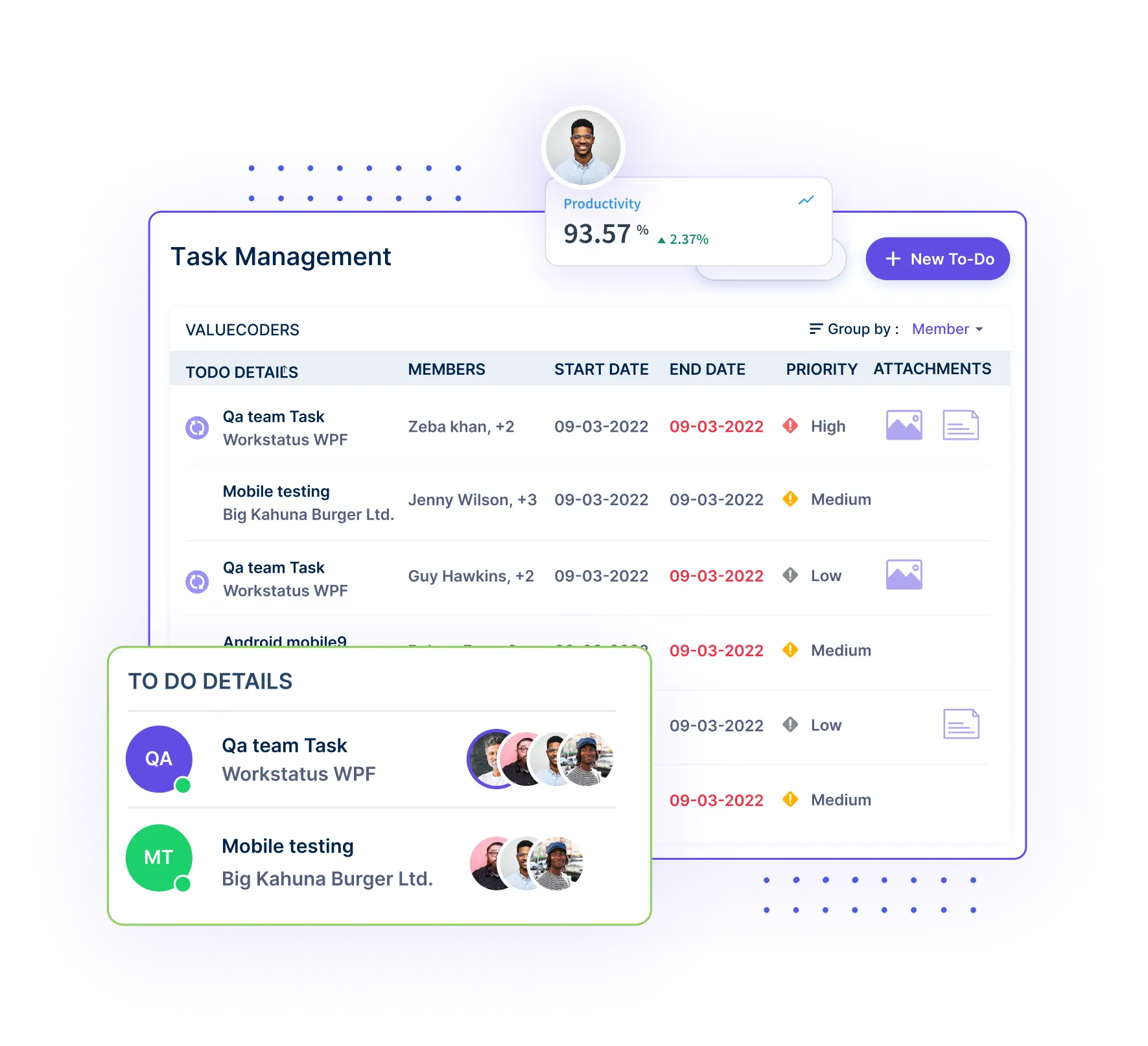 Workstatus enables managers to manage tasks through its assignment and prioritization system, which tracks task progementgress.
Workstatus enables managers to manage tasks through its assignment and prioritization system, which tracks task progementgress.
The platform connects distributed teams to deadlines and project targets, strengthening members’ teamwork and ensuring smooth on-time task completion.
GPS Tracking
![]() For field-based teams, Workstatus offers GPS tracking to monitor location and on-site hours.
For field-based teams, Workstatus offers GPS tracking to monitor location and on-site hours.
This feature ensures employees are at the right job sites and working the necessary hours, providing better coordination and compliance for teams in different locations.
Reports & Analytics
 Workstatus creates comprehensive reports that record employee productivity monitoring levels alongside data regarding application utilization and work duration at each task.
Workstatus creates comprehensive reports that record employee productivity monitoring levels alongside data regarding application utilization and work duration at each task.
These business insights drive data-driven decisions, helping identify top team members and key areas for improvement via reporting and analytics.
Break Management
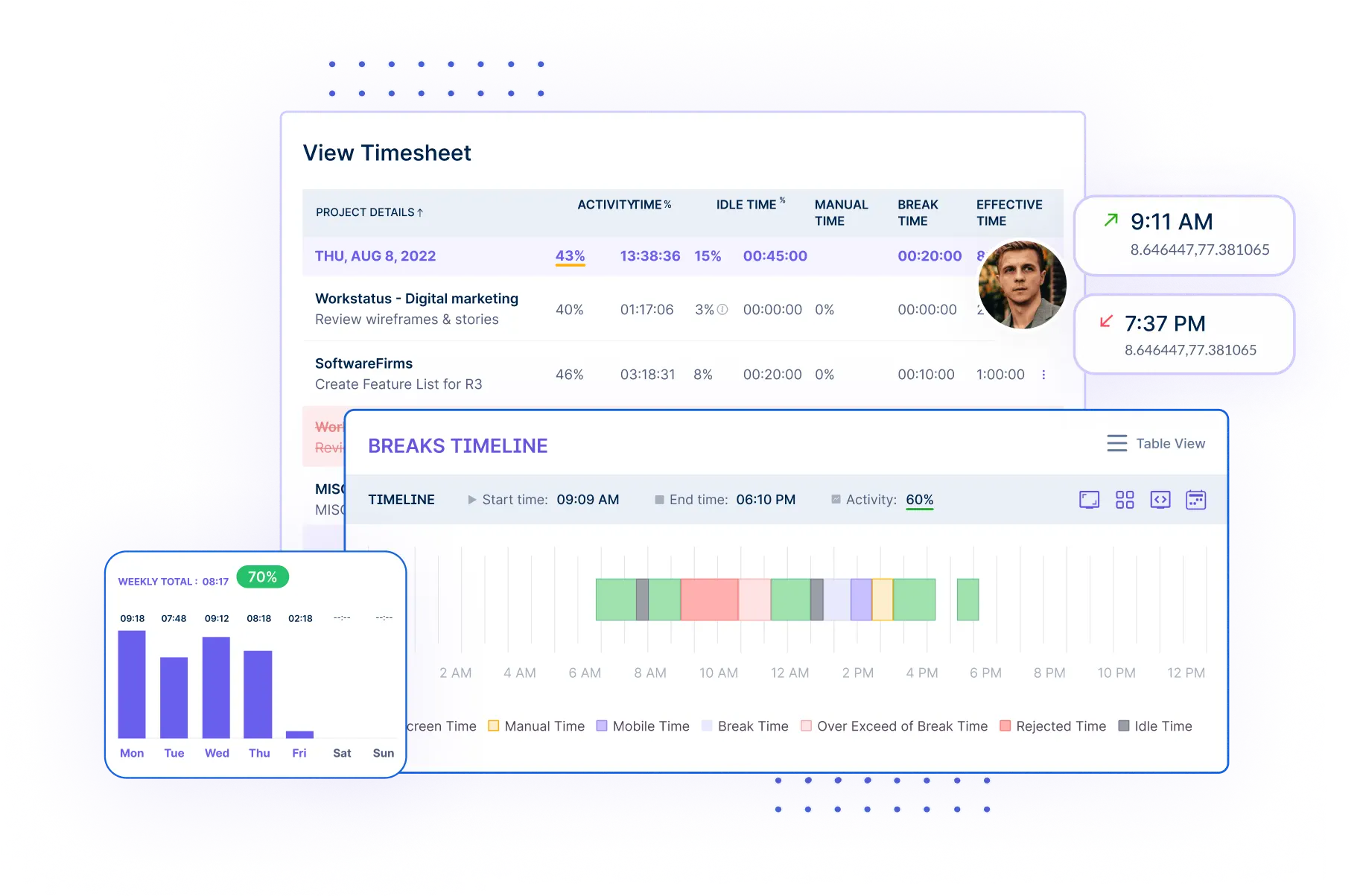 The Smart Break feature promotes staff members to follow scheduled break windows so work-related fatigue reduces while focus strengthens.
The Smart Break feature promotes staff members to follow scheduled break windows so work-related fatigue reduces while focus strengthens.
Frequent rest periods help workers stay focused when they return to work. This boosts their performance and leads to better long-term results.
Payroll Management
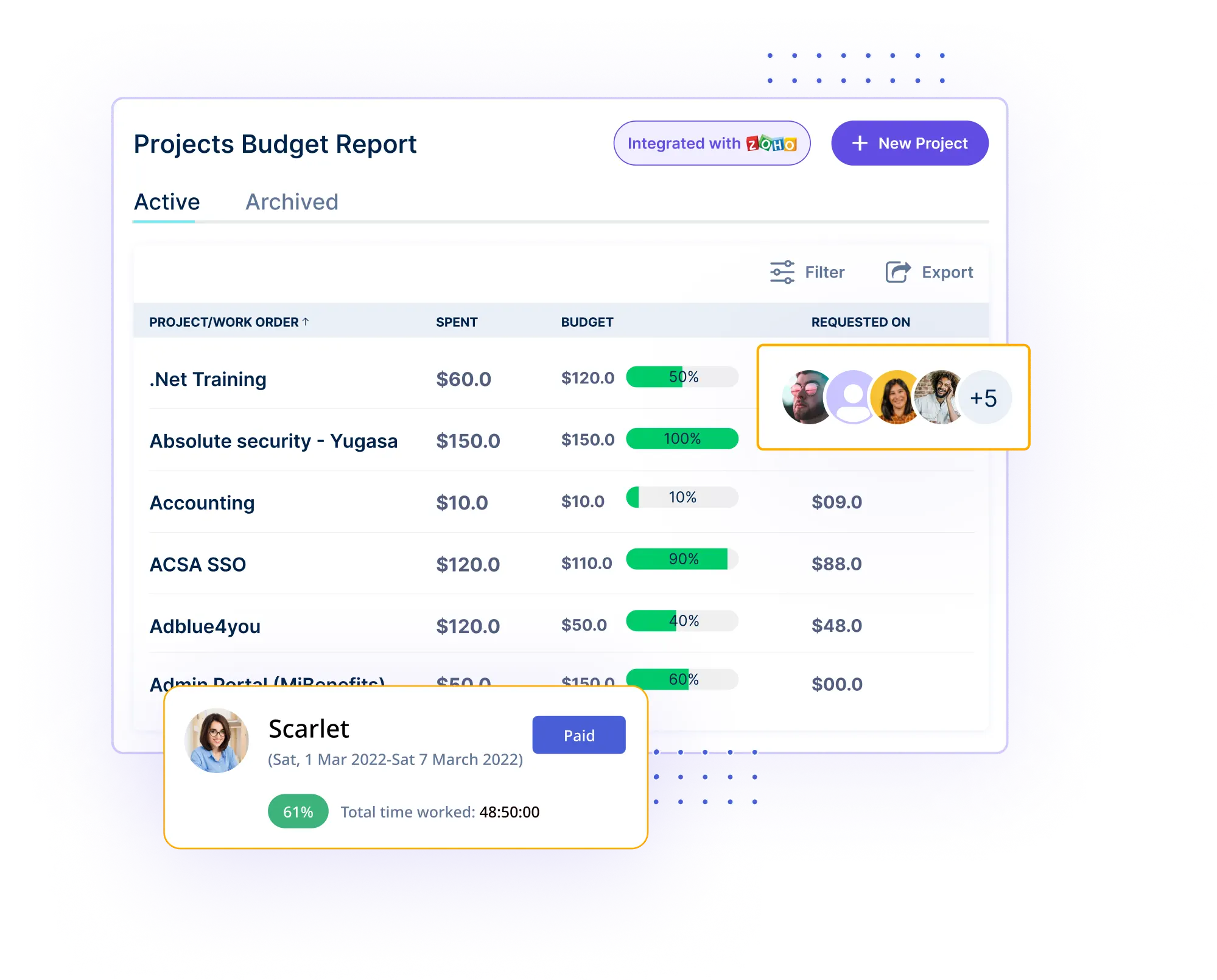 Workstatus simplifies payroll by providing accurate, automated time tracking. This ensures employees are paid correctly and on time, reducing administrative tasks and errors, especially for teams working across multiple time zones.
Workstatus simplifies payroll by providing accurate, automated time tracking. This ensures employees are paid correctly and on time, reducing administrative tasks and errors, especially for teams working across multiple time zones.
By combining these features, Workstatus helps remote teams stay efficient, engaged, and motivated. With accurate workforce analytics software, task management, and detailed analytics, businesses can optimize workflows and boost overall remote team productivity.
Ways to Scale Remote Teams in Different Industries
Remote team scaling requires adopting specific approaches that address different industrial requirements. Among fundamental principles such as communication and productivity management, unique market challenges emerge differently for each sector.
These industries implement remote team management according to the following approaches:
Staffing and Recruiting
Staffing needs rapid growth of teams to succeed. By employing automation tools for hiring and candidate administration staffing agencies maintain their operational speed and quality standards throughout scale increases.
E-Commerce
The workforce of e-commerce teams depends on remote staff who perform marketing and customer service as well as order fulfillment tasks.
A combination of multi-time zone customer support with automated inventory and customer inquiries functions enables efficient scaling.
Software and IT
For software and IT, managing remote teams requires tools like Workstatus for collaboration.
CI/CD practices support seamless teamwork across time zones, while strong cybersecurity measures are essential as teams grow.
Consulting
Consulting teams thrive remotely, but scaling requires effective communication with clients and team members.
Project management tools like Workstatus and communication platforms like Zoom ensure smooth operations and quick onboarding for new consultants.
Digital Marketing
Scaling a remote digital marketing team means balancing creativity with data-driven strategies. Tools for project management and communication help maintain consistency across campaigns and ensure timely deliverables.
Using the right productivity tools for remote teams and CEO strategies for remote work, businesses can scale their remote teams successfully, driving growth and success in each industry.
Closing Thoughts
In conclusion, a strategic approach combined with comprehensive measures must be implemented to advance remote team productivity by 30%.
Success depends on excellent leadership, advanced communication systems, and evidence-based decision-support measures.
CEO productivity tips need to build an accountable, autonomous environment supplemented by applicable resources and appropriate support structures.
Thus, Workstatus enables CEOs to reach these goals by implementing remote employee monitoring in real time, managing assignments, and reporting on productivity, which prevents worker micromanagement.
Properly implementing strategic approaches and workforce management software ensures that remote teams will maintain their current performance and excel, producing superior results that lead to sustained business expansion.
FAQs
Ques: How can remote teams stay motivated and engaged?
Ans: Regular feedback and achievement recognition and collaborative teamwork environments and productivity tools ensure remote teams stay highly motivated in their work activities.
Ques: What strategies can CEOs use to boost remote team productivity?
Ans: CEOs should establish definite objectives while promoting accountability and improving communication infrastructure and developing productivity solutions and creating employee commitment practices to advance performance efficiency.
Ques: How can CEOs ensure accountability in remote teams?
Ans: By implementing structured reporting alongside clear expectation definition and using Workstatus activity tracking tools, managers establish accountability levels in remote teams without implementing micromanagement techniques.
Ques: What benefits do CEOs gain from optimizing remote team productivity?
Ans: Having well-managed remote employees delivers higher productivity, satisfied workers, lowered operations costs, and scalable business advantages.
Ques: Why is work-life balance important for remote teams?
Ans: When work-life balance disappears, employees face increased burnout levels alongside decreased focus, resulting in weaker job satisfaction and negative impacts on team productivity and retention rates.












